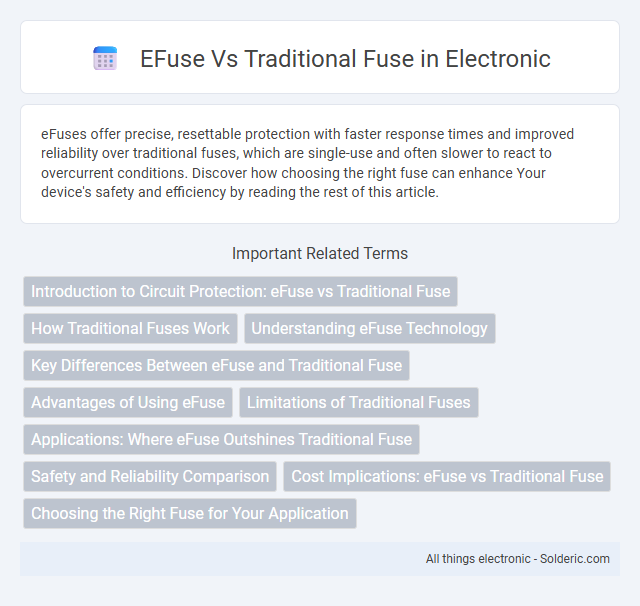eFuses offer precise, resettable protection with faster response times and improved reliability over traditional fuses, which are single-use and often slower to react to overcurrent conditions. Discover how choosing the right fuse can enhance Your device's safety and efficiency by reading the rest of this article.
Comparison Table
| Feature | eFuse | Traditional Fuse |
|---|---|---|
| Type | Electronic fuse (solid-state) | Mechanical fuse (wire or strip) |
| Response Time | Fast, milliseconds | Slower, seconds to minutes |
| Reset Capability | Auto-reset or manual reset | Single-use, must replace after blowing |
| Precision | High, adjustable trip current | Low, fixed trip current based on fuse rating |
| Durability | Long lifespan, no mechanical wear | Limited, fuse element degrades or melts |
| Cost | Higher initial cost | Lower cost |
| Applications | Modern electronics, precision circuits, power management | Household wiring, automotive, simple electrical systems |
| Size | Compact, integrated in ICs | Varies, often larger |
| Maintenance | Minimal, often automatic | Requires replacement upon blow |
Introduction to Circuit Protection: eFuse vs Traditional Fuse
eFuses provide advanced circuit protection through integrated semiconductor components that enable precise current regulation and automatic reset after fault conditions, unlike traditional fuses that rely on a physical wire melting to interrupt current flow. eFuses offer faster response times, improved reliability, and enhanced control features such as overcurrent, overvoltage, and thermal protection, reducing downtime and maintenance costs. Traditional fuses are simpler and less expensive but require manual replacement after activation, limiting their effectiveness in modern electronic applications.
How Traditional Fuses Work
Traditional fuses work by containing a metal wire or filament that melts when excessive current flows through it, interrupting the circuit and preventing damage to electrical components. The melting point of the fuse wire is precisely calibrated to blow at specific current levels, ensuring reliable protection against overcurrent conditions. Your electrical system relies on this simple but effective mechanism for safeguarding circuits against short circuits and overloads.
Understanding eFuse Technology
eFuse technology offers advanced circuit protection by integrating semiconductor components that detect and interrupt overcurrent conditions faster than traditional fuses, which rely on melting metal strips. Your electrical systems benefit from eFuses' precise current limiting and resettable functionality, reducing downtime and maintenance costs. Unlike traditional fuses that require replacement after a fault, eFuses provide intelligent protection with real-time monitoring and automatic reset capabilities.
Key Differences Between eFuse and Traditional Fuse
eFuse offers precise electronic control with built-in reset functionality, unlike a traditional fuse that requires replacement after a fault. It provides faster response times and can communicate status information for better system monitoring. Your choice between eFuse and traditional fuse affects reliability, maintenance efficiency, and protection accuracy in electronic circuits.
Advantages of Using eFuse
eFuse offers enhanced protection with faster response times and precise current limiting compared to traditional fuses, reducing the risk of damage to sensitive electronic components. Its ability to reset automatically eliminates the need for fuse replacement, saving time and maintenance costs in your electronic systems. Furthermore, eFuses provide integrated diagnostics and smarter fault detection, improving overall system reliability and safety.
Limitations of Traditional Fuses
Traditional fuses have limitations such as a fixed current rating that cannot be adjusted, leading to potential inconvenience and increased inventory for various applications. They suffer from slower response times compared to eFuses, increasing the risk of damage during transient faults. Additionally, traditional fuses provide no reset capability and require physical replacement after tripping, causing extended downtime and maintenance costs.
Applications: Where eFuse Outshines Traditional Fuse
eFuse technology excels in applications requiring precise electronic circuit protection, such as USB power delivery, battery management systems, and sensitive semiconductor devices, where traditional fuses fall short due to their slower response times and lack of reset capability. eFuses provide superior integration in compact electronics, enabling real-time overcurrent and thermal protection with programmable thresholds, unlike traditional fuses that require physical replacement after a fault. High-reliability sectors like automotive, telecommunications, and consumer electronics increasingly favor eFuses for their enhanced durability, fast reaction, and automatic reset functionality, ensuring minimal downtime and improved system resilience.
Safety and Reliability Comparison
eFuses offer enhanced safety and reliability compared to traditional fuses by providing precise overcurrent protection with fast response times and automatic reset capabilities, reducing downtime and maintenance costs. Unlike traditional fuses that permanently fail and require replacement, eFuses protect your electronic circuits from damage through real-time monitoring and controlled current limiting. This advanced protection minimizes the risk of catastrophic failures and improves overall system dependability in critical applications.
Cost Implications: eFuse vs Traditional Fuse
eFuses generally have higher upfront costs compared to traditional fuses due to integrated circuitry and enhanced protection features but offer long-term savings by reducing downtime and replacement frequency. Traditional fuses are cheaper initially but may lead to higher maintenance costs and potential damage to equipment during failure. Evaluating total cost of ownership reveals eFuses as more cost-effective in critical applications requiring reliable and quick fault detection.
Choosing the Right Fuse for Your Application
Choosing the right fuse for your application involves understanding the differences between eFuse and traditional fuses, particularly in terms of response time and reset capability. eFuses provide precise overcurrent protection with fast electronic response and automatic reset, making them ideal for sensitive electronics requiring reliable, repeatable protection. Traditional fuses, while cost-effective and simple, need replacement after a fault and are better suited for applications where infrequent overcurrent events occur and manual intervention is acceptable.
eFuse vs traditional fuse Infographic

 solderic.com
solderic.com